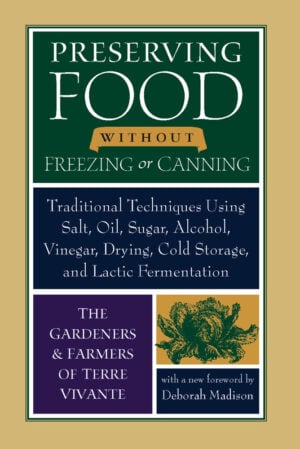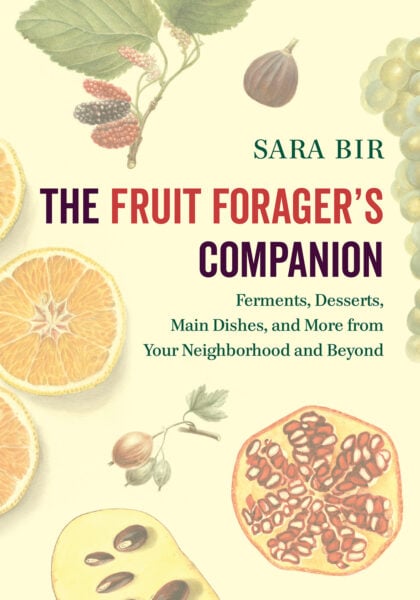How to Make Whole Fruit Jam

Soak up the end of summer by whipping up some whole fruit jam with seasonal fruits!
The best part of this sweet spread? There’s absolutely no sugar added. This recipe relies on natural sugars to provide a balanced flavor.
The following is an excerpt from Preserving Food Without Freezing or Canning by the Gardeners and Farmers of Terre Vivante. It has been adapted for the web.
Whole Fruit Jam: Save the Sugar
Sugar is a practical and economical method of food preservation—so much so that we tend to overindulge, and make jams that contain more sugar than fruit! When we discover that excess sugar is one of the great scourges of the modern diet, we might think it best to renounce jams completely.
Besides, replacing white sugar with brown sugar is only a relative improvement. Whole or raw sugar (evaporated juice from sugar cane) would be a better substitute, but its strong flavor often masks the taste of the fruit.
A Sweet Solution
The solution to this problem is twofold:
- Avoid eating too much jam and other sugary foods.
- Make these foods using far less added sugar, or none at all.
Knowing and applying these techniques, we can continue to preserve food properly and successfully. For example, certain jams made with very little sugar must be refrigerated once opened, preferably in small jars, to prevent premature spoilage.
For those recipes that require sugar, we will use either brown or whole sugar. Other recipes are “sugar-free,” or use honey instead.
Note that the term “sugar-free jam” in essence is a contradiction in terms, since by definition, sugar is the preservative agent in jams. To be more precise, we should discuss “jams with no added sugar.” In reality, jam already contains sugar: both glucose and fructose, which naturally occur in all fruit.
The Journey of Jam
Jams with no added sugar were not invented by health-food advocates wanting to reduce their sugar consumption. These preserves are an old tradition dating back to a time when sugar was scarce and expensive (or even nonexistent). Three classic examples, and the most commonly known jams of this type, are pommé (apple jelly), poiré (pear jelly), and raisiné (grape jelly).
The first two have been made for centuries in certain regions of northern Europe, particularly Belgium and Germany, whereas the raisiné is a tradition of Périgord in southwestern France. Carob “honey” is a similar preserve that is found in the Middle East, Galilee (recipe follows in this chapter). All these preserves share this common feature: They are made from the juice only, and not from the whole fruit. Thus, they are jellies or thick syrups, rather than jams.
Their preparation is based on this simple principle: Prolonged cooking evaporates enough water to concentrate enough of the naturally occurring sugars for preservation to take place. Jams from whole fruit can also be prepared by following the same principle. In general, after pouring hot jam or jelly into a jar and sealing it, turn the jar upside down. This will sterilize any air remaining in the jar and ensure preservation. It’s also a good idea to store the jars upside down.
RECIPE: Whole Fruit Jam
- Very ripe fruit (any type)
- A preserving pan or large saucepan
- Canning jars and lids
This method is good for all types of fruit, including grapes, greengage plums, and so on.
Use fruit that is very ripe; simply cut and crush it roughly.
Bring the fruit to a boil; then cook it over very low heat for a very long time.
It is impossible to recommend a precise cooking time, since this depends on the type of fruit used, and its ripeness and water content, both of which vary from one year to the next. In any case, you should allow as much water as possible to evaporate.
Stir often, because certain fruits have a tendency to stick during cooking. The jam is ready when it does not run off of the spoons but forms a bead that sticks to the spoon. At this stage pour the jam into scalded screw-top jars. It will keep for at least two years.
Variation 2:
- Red currants or other acidic fruit
- Honey or raisins (½ weight of fruit)
For red currants, for example, you can add honey; for other very acidic fruit, you can add raisins (about half the weight of the fruit); or you can mix fruits.
Recommended Reads
Recent Articles
This tried-and-true jam recipe relies on the natural sugars in fruit to provide a balanced flavor and sweetness that can’t be beat.
Read MoreWith the “dog days” of summer underway, the heat can feel a little unrelenting. On hot days, there’s no better way to cool off than with a refreshing, cold beverage. Here’s a list of some perfect cool-down summer drinks made with organic ingredients sourced right from your garden or local wild places. The following excerpts have…
Read MoreThink about how much work your perennial flower beds take compared to your annual vegetable garden. In a busy year, your perennial garden largely sails through despite neglect. Once your perennials are established, and if they are suited to your climate and site conditions, they can be virtually indestructible. An annual vegetable garden, as we…
Read MoreGot some daylilies taking over your garden? Instead of weeding them out, try eating them instead! A common vegetable in China and Japan, the daylily is more than a pretty flower. These wild plants are easy to forage and packed with flavor that will serve as a perfect addition to seasonal recipes. Before trying them,…
Read MoreTending to your garden is fulfilling in its own way, but the real reward is when everything is ready to be harvested! See below for some tips for harvesting and preserving that’ll keep you nourished for months to come. The following is an excerpt form The Regenerative Grower’s Guide to Garden Amendments by Nigel Palmer. It…
Read More









